In & Around Udaipur
-
Ahar Cenotaphs
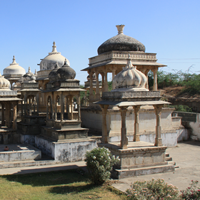
Located about 2 kms east of Udaipur is an impressive cluster of cenotaphs of the Maharanas of Mewar. There are about nineteen cenotaphs of Maharanas cremated there. The most striking cenotaph is that Maharana Amar Singh, who reigned from 1597 to 1620. Nearby is also Ahar Museum, where on display is limited but very rare earthen pottery. Some sculptures and other archaeological finds. Some pieces date back to 1700 BC and a tenth century metal figure of Buddha is a special attraction.
-
Crystal Gallery
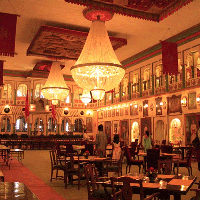
It is situated in the Fateh Prakash Palace is a breath taking collection of crystals. Maharana Sajjan Singh mainly ordered these crystals from F & C Osler England. But he could not see the crystals because of his untimely death. The crystal item includes tables, sofa sets, dinning table, dressers, fountains and even beds besides a whole array of washing bowls, decanters and perfume bottles. There is also an exquisite jewel studded carpet, which is beyond description.
-
Dudh Talai
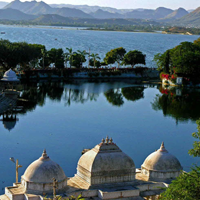
A beautiful laid out "Rock Garden" from where one can enjoy sunset view in Lake Pichhola and panoramic view of old city. Musical Fountain is an another attraction for the visitors.
-
Rope Way Udaipur
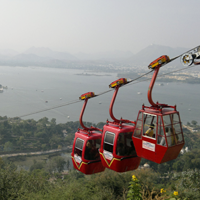
Udaipur Ropeway is a prestigious project commissioned in June 2008. The promoters Omkareshwar Tradelinks Private Limited are engaged in promoting tourism in the state of Rajasthan by way of launching a number of adventure projects to enable visitors to get more value for their money. Forthcoming projects in the state of Rajasthan are Amusement Park at Gulab Bagh, Sport fishing and power gliding/para sailing.
-
Fateh Sagar Lake
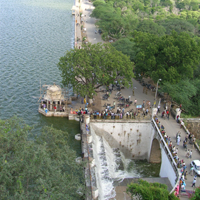
This delightful lake, bordered by hills and woodland was constructed by Maharana jai Singh to the north of Lake Pichola. It is an artificial lake dug up in 1678, reconstructed by Maharana Fateh Singh A canal links the two, via Swaroop Sagar and Rang Sagar Lakes. The beautiful Nehru Island as well as an islet bearing a solar observatory rises from the lake.
-
Ghangaur Ghat
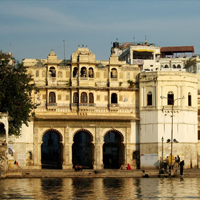
This is a very congenial old building built right on the waterfront of Lake Pichola at Gangori Ghat. Amir Chand Badwa, the Prime Minister of Mewar built it in the eighteenth century. The palace has over hundred rooms and some very interesting display of costumes and modern art. It also preserves a fine example of Mewar Painting on the walls of Queen's Chamber. The two peacocks made from small pieces of colored glasses are fine examples of glasswork. After the death Badwa the building became the property of Mewar State. It came to be occupied by Maharana Shakti Singh of Bagore who built the palace of the three arches also in 1878 and it acquired its name of Bagore-ki-haveli, the house of Bagore.
-
Jagdish Temple
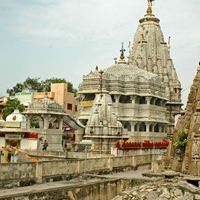
Built by Maharana Jagat Singh I in 1651 the temple enshrines a black stone image of Lard Vishnu. There is a brass image of Garuda the Lord bird carrier. The exterior and the plinth are covered with base relief of alligators; elephants, horsemen and celestial musicians rise in tiers. Chanting, bells and music can be heard throughout the day. It is the largest and most splendid temple of Udaipur.
-
Jag Mandir
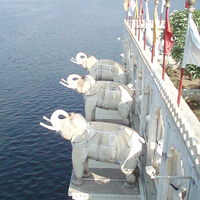
A majestic architectural marvel towering over the lake on a hill surrounded by crenallated walls, it is a conglomeration of courtyards, pavilions, terraces, corridors, rooms and hanging gardens. The main entrance is through the triple arched gate, the "Tripolia" with eight marble porticos. The maharanas were weighed under the gate in gold, the euivalent amount of which was distributed among the populace.
-
Moti Magri
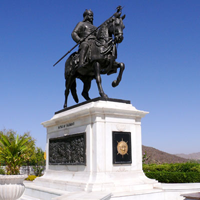
This is the other island palace in Lake Pichola, which was constructed by Maharana Karan Singh as a hideout for Prince Khurram the estranged son of Emperor Jehangir the implacable foe of the Maharana. The reason for the aid was that the prince was the son of a Rajput mother. It is also said that Shah Jahan [prince Khurram] derived some of these ideas for the Taj Mahal from this palace when he stayed there in 1623-24. The island has some striking carving including a row of elephants that looks as though they are guarding the island. The exquisitely carved chhatri in grey and blue stone is another example.
-
Sahelion ki Bari
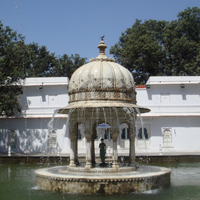
Saheliyon ki Bari or the "Garden of the maids of honour", brings to the fore the unique life-style of the royal ladies who once strolled in this gardens. This spectacular garden has four pools and five fountains, each one with a different look, embelished with delicately chiselled kiosks and elephants in marble. It also has a Science Laboratory with different types of reptiles, frogs and specimens for the visitors.
-
Sajjan Garh
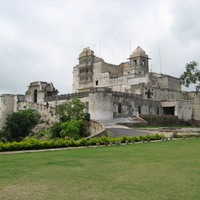
Sajjangarh Wildlife Sanctuary is situated 5kms in the West of tourist city Udaipur, which surrounds the Sajjangarh Palace overlooking Udaipur City. From the palace, one can have a magnificent view of lakes of Udaipur and Aravalli hill ranges. The view of Sunrise and Sunset attracts every visitor atop of Bansdara hill. Safari Park was created and wild animals like Chital, Sambar, Wild Boar, and Blue Bull were reintroduced. Animals like Panther, Hyena, Hare and Jackal has reappeared apart from variety of reptiles and birds. The wall extended further and now the entire hillock has been fenced, improving the vegetal cover of the sanctuary area.
-
Shilpgram
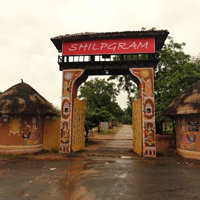
Literally meaning a "Craftsmen's Village" is a living ethnographic museum depicting the enormous diversities in craft, art & culture between various Indian states, but the exquisite terracotta work mainly in dark red and dark brown sand material along with the wooden carvings are the forte of this ethnic village . Shilpgram comprises 26 huts set in 70 acres of natural surroundings at the foot of the Aravali Hills.A colourful craft festival during winter seasons to the whole set up induces viatanity and zeal.
-
Sukhadia Circle
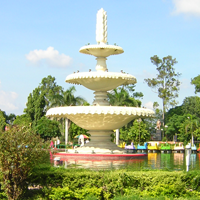
Udaipur, a large round about in the city's northern suburb of Panchwati, on the road to Ranakpur and Mt. Abu. The centrepiece of the Circle is a large, three-tiered fountain just over 21 m. high, with scalloped dishes surmounted by a wheat-ear motif, representing prosperity. Illuminated at night, it is now a well-known landmark. Its foundation was laid in 1968 and was opened in 1970. The Circle is a popular recreational centre and meeting place. A circular pond surrounds the fountain; nearby are pleasant gardens.
-
The City Palace
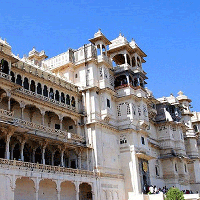
A majestic architectural marvel towering over the lake on a hill surrounded by crenallated walls, it is a conglomeration of courtyards, pavilions, terraces, corridors, rooms and hanging gardens. The main entrance is through the triple arched gate, the "Tripolia" with eight marble porticos. The maharanas were weighed under the gate in gold, the euivalent amount of which was distributed among the populace.
-
The Vintage Car Collection
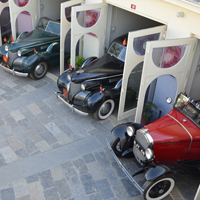
The collection within the grounds of the Garden Hotel comprises a variety of classic and interestingly rare transportation vehicles; some stately and vintage like Cadalec, Chevalate, Morais etc., while the others are sleek and fast .The Maharanas of Udaipur once possessed and used these regal splendours of automobiles as their luxuries but most of the other models are gradually being added to the collection ,since it provides a unique aristocratic safari for the exclusive guests.







